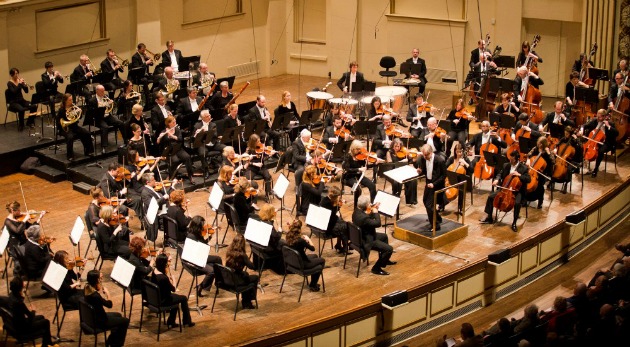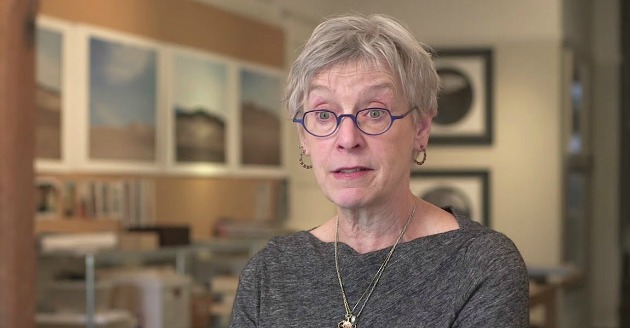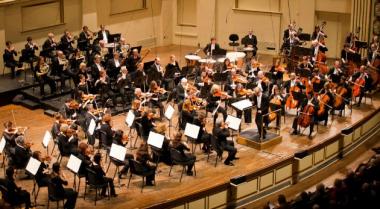
Conductor David Robertson’s connection to Olivier Messiaen’s monumental Des canyons aux étoiles… (From the canyons to the stars…) began with his childhood trips to America’s national parks — the same parks that provided the inspiration for Messiaen’s work. That's what he told his audience at UC Berkeley’s Zellerbach Hall last Sunday, before leading his St. Louis Symphony in a performance of the 90-minute work.
In an attempt to bring audiences closer to the wonders of the canyons and peaks that so moved Messiaen when he visited the United States in the early 1970s, Robertson solicited the help of landscape photographer Deborah O’Grady in creating a big-screen photo/video installation that could accompany the score. Following in the footsteps of the composer, O’Grady photographed the same Utah destinations that Messiaen visited — Cedar Breaks, Bryce Canyon, and Zion National Park.

There’s no denying that O’Grady’s images were stunning. A mountain silhouetted against the pink glow of sunset accompanied “The Desert,” the opening movement of Des Canyons. During “Bryce Canyon and the Red-Orange Rock,” long, loud blats from the trombones were the perfect accompaniment for O’Grady’s shots of the canyon’s alien hoodoos, finger-like rock formations that jut up from the ground.
However, these landscape images soon lost their effect through sheer repetition. It felt almost like flipping through the generic desktop wallpapers and screen savers that come preloaded on a laptop. Robertson didn’t seem to trust the audience to grasp the aural snapshots of Bryce Canyon and Zion National Park already there in Messiaen’s score. In fact, O’Grady herself said it best during the concert’s introductory remarks when she recalled her first experience hearing the St. Louis Symphony play Des Canyons live: “The canyons sprang to life in the room.”
Much of Messiaen’s music in Des Canyons is arranged modularly; blocks of contrasting sound are carefully laid out, one after another, piecing together a kind of mosaic. The aeoliphone (wind machine) emits the sound of rushing wind. Pause. The brass plays a kind of chorale. Pause. Pianist Peter Henderson spins out a transcription of birdsong on the piano. Pause. The orchestra plays an off-kilter dance in one of Messiaen’s exotic “modes of limited transposition.” And so it goes.
As this process unfolds, we hear the Human juxtaposed with the Natural; the Beautiful with the Sublime; the Miniscule with the Massive. While some of these modules are intended to conjure visual images via a kind of synesthesia, their arrangement in the work also elicits emotional or spiritual reactions to viewing the marvels of these parks — intangible experiences that can only be recreated through music.
Indeed, Messiaen’s piece is about more than canyons and stars, as the title (and O’Grady’s photos) would have us believe. As a devout Christian who adhered to a mystical strain of Catholicism, Messiaen was concerned with concepts beyond the earthly: infinity, eternity, divine love, and the sacred mysteries.
Horn player Roger Kaza tapped into this religious side of the work during his horn solo “Interstellar Call.” The movement began with proud hunting calls, but Kaza followed these up with delicate, near-inaudible melodic lines that were then repeated to create an echo effect, which died away into long stretches of silence. Kaza phrased these lines like questions posed to the infinite void — the kind of existential “Who am I?” and “Why am I here?” questions that plague all of us late at night and can only be answered through faith.
For the most part, Robertson was also able to channel the metaphysical, especially during movements when O’Grady’s slideshow was reduced to single images and took a backseat to the music. In “The Resurrected and the Song of the Aldebaran Star,” the orchestra conjured a celestial sphere through a soft halo of strings and tiny stars evoked by the tinkling of piano, xylophone, tubular bells, and wind chimes. In the hands of Robertson and the St. Louis Symphony, this became the concert’s most transcendental and awe-inspiring moment. There was not much thematic development — instead, it is almost as if the audience was encouraged to mentally “move about” this musical space and ponder the kinds of questions posed by Kaza’s solo.
Yet in other movements, Robertson’s interpretation seemed tied down, like O’Grady’s photos, so that the score became pictorial rather than a spiritual exploration. In the end, you got the sense that if the conductor had been freed of his visual imagination, he would have been able to push the music toward the kinds of infinite extremes Messiaen wanted. If only the pillar-like chords of “What is Written in the Stars…” had been a bit more booming and expansive; if only the blazing A-major chord that ends the work had been held a bit longer.

